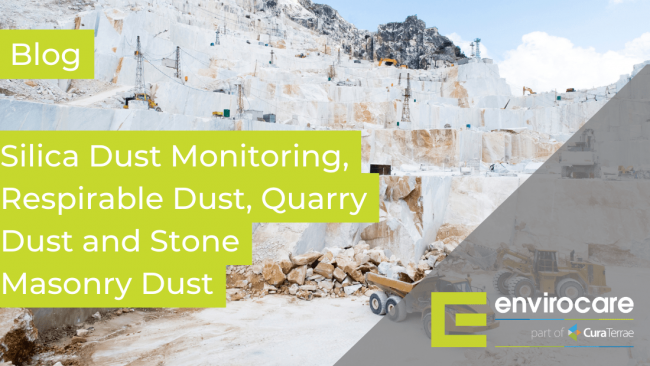Silica Dust Monitoring, Respirable Dust, Quarry Dust and Stone Masonry Dust
3 July 2014

Dusts can be classified as either total inhalable dust or respirable dust when referring to Silica dust monitoring. The different categories relate to the size of the dust particles in the atmosphere with respirable dust being finer and thus able to penetrate further into the lungs where it remains. Dust can be created from a whole host of operations both manual and mechanical. The use of power tools, in particular grinding, cutting, and sanding, can create large quantities of dust. If this is not properly managed, it can cause ill health to employees if they are exposed over a significant length of time. This silica dust is a major issue, second only to asbestos lung disease in numbers of people affected.
This article reveals the health hazards from cutting and working stone building materials. Hazardous levels of dust can be created by traditional construction work and also small scale building work. The dust can often contain silica, which is a more serious health hazard than normal dust that is breathed in by workers. The biggest concern in this type of exposure is that too many workers are not even aware that this is a potential problem for them. However the dust can be controlled and health risks minimised by utilising the principles outlined in the COSHH regulations.
Dust can be created from a whole host of operations both manual and mechanical. The use of power tools, in particular grinding, cutting and sanding can create large quantities of dust that if not properly managed can cause ill health to employees if exposed over a significant length of time.
Occupational Health Risk
A major health risk encountered by people working in the quarrying industry is exposure to fine respirable dust which contains silica. Silica is found in the majority of rocks, sands and clays and therefore workers within the quarrying industry and masonry industry are particularly susceptible. Silica dust exposure to workers can arise from the quarrying of stone but also from small scale working such as cutting and processing of kerbstones, block paving, bricks, flags and tiles. Regardless of the scale, Silica Dust Monitoring is vital for the safety of your employees.
Other work sectors include mining of stone and refractory manufacturing, pottery, cement production, ceramics and sandblasting processes. Workers are at risk from fine airborne particles, entering into the respiratory tract. However, these small particles are often not visible to the naked eye and therefore may not be an obvious exposure risk to workers. Exposure over a number of years can lead to the development of the condition known as silicosis. This is a form of scar tissue in the gas exchange region of the lungs that leads to difficulties in oxygen uptake into the bloodstream. Furthermore new evidence suggests that long term exposure to silica can increase the risk of the development of lung cancer.
The main health effects associated with dust exposure are bronchitis, asthma, and (in extreme cases) cancer. The effect that the dust can have on the body will depend upon the substance that is worked to create the dust. Silica and hardwoods are known to be particularly hazardous to the body and are given lower Workplace Exposure Limits (WEL). WELs can be used to show areas and operations where employee exposure is above a known “safe” limit.
Silica Dust Monitoring is carried out through the use of personal samplers that can be set up to assess the exposure of employees to dust that is created from any operations that are being carried out during the sampling period. In addition to the sampling, observations are carried out by one of our consultants to assess the work practices to identify any problem areas and to suggest ways of improving the work practices to reduce employee dust exposure. Results of the tests can be tailored to any length of shift patterns in order to show typical exposure limits for the site.
In order to Control Exposure and protect employees it is important to discover the level of exposure to ensure that adequate control measures are introduced. The assumption of compliance is not enough; measures are required to prove that the risks have been adequately assessed.
Companies where this dust may occur have been targeted and informed to use methods to cut and break such materials to avoid dust creation and by damping materials when cutting to stop dust getting into the air. Special, high efficiency vacuums or dust suppressant tools may be used to remove the dust. Where PPE is concerned (always as a last resort after considering other options first) then high quality and efficiency dust masks must be used by workers, and they must be trained to use them properly and at the times of highest dust exposure in order to gain the best protection in this hazardous situation.
Under the Control of Substances Hazardous to Health (COSHH) Regulations 2002 employers must make suitable and sufficient assessment of the health risks created by work which is liable to exposure their employees to substances hazardous to health.
In addition, as silica is linked to cancer, exposure must be reduced to as low levels as is reasonable practicable. The Workplace Exposure Limit (WEL) is low at 0.1mg/m3 (8hr time weighted average, or TWA), which must not be exceeded.
Adherence to the regulations will provide the following benefits for employers and their employees:
- Improve productivity due to lower levels of ill health
- Improve employee morale
- Lower the number of civil court claims
Experts In Silica Dust Monitoring
Envirocare can provide assistance by carrying out independent UKAS accredited air quality testing and silica dust monitoring within the quarrying workplace. COSHH air monitoring work can provide a crucial part in aiding the production of your COSHH Risk Assessments. Our service includes expert technical advice tailored to the needs of the individual quarry. These include:
- Assessing operative exposure to respirable dust and silica levels and ensure levels are not above permitted Workplace Exposure Limit (WEL) values.
- Recommend further control measures to be put in place in order to reduce the risk of ill health to your employees.
- Thorough workplace observations recommend actions in ensuring you meet your obligations in reducing exposure to as low as is reasonably practicable.
Call us on 01274 738668 or fill out our Envirocare Enquiry Form for any queries regarding silica dust monitoring, COSHH Air Monitoring and workplace dust sampling.
